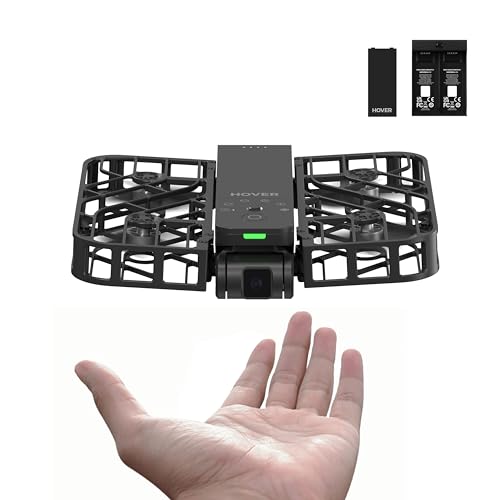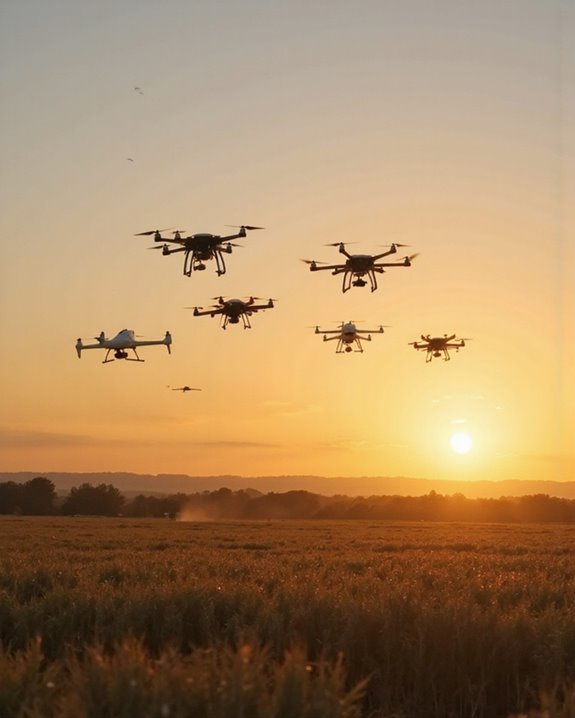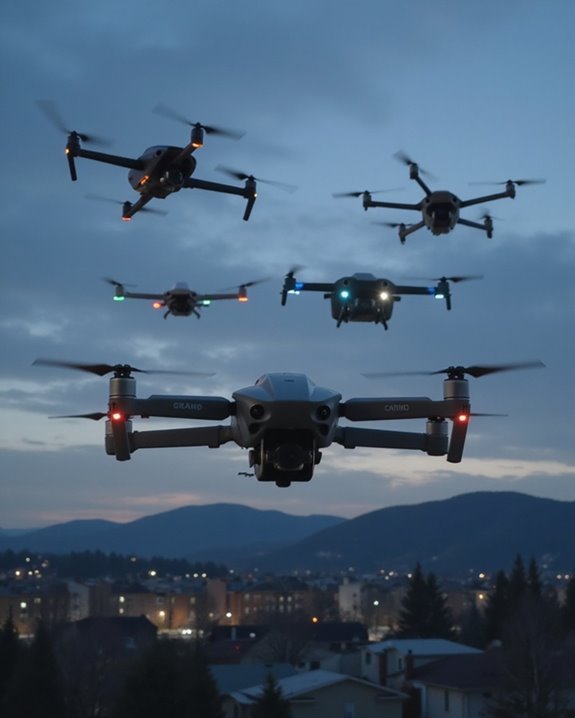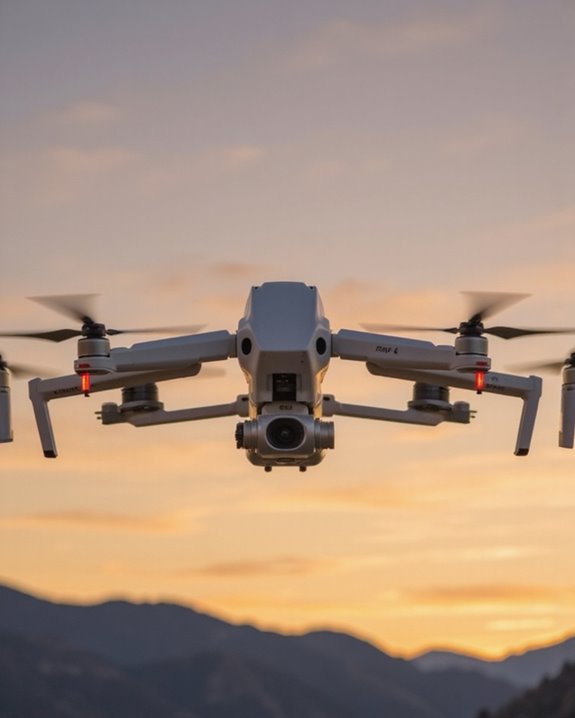Today’s mini drones pack serious punch in tiny packages! You’ll love the Ruko F11PRO 2 with its 6K camera and impressive 70-minute flight time, or the self-flying X1 for hassle-free aerial footage. The Potensic ATOM delivers 4K video with a 3-axis gimbal, while beginners will appreciate the 2K HD Foldable Drone’s user-friendly features. Don’t overlook the affordable 1080P option with multiple control methods! These pocket-sized powerhouses prove that incredible aerial photography doesn’t require bulky equipment.
Key Takeaways
- Ultralight drones under 250g deliver impressive 4K video capabilities with QuickShots for creative social media content.
- Portable mini drones offer up to 96 minutes total flight time from swappable batteries for extended photography sessions.
- Advanced stabilization systems like 3-axis gimbals ensure steady footage even in challenging wind conditions.
- Beginner-friendly models include one-key takeoff, headless mode, and multiple control options ideal for new pilots.
- Mini drone price points vary based on camera quality, from affordable 1080P options to premium 6K models with intelligent features.
Ruko F11PRO 2 Drone with 6K Camera and 3-Axis Gimbal
- 【Soar into Summer Memories】From backyard BBQs to your kid's first bike ride, these are the moments they'll remember. With crisp 6K photos and smooth 4K/30fps video,...
- 【Advanced Image Sensor Lens】F11PRO 2’s premium image sensor lens outshines standard lenses, capturing finer details and richer textures, bringing your world to life...
- 【Stability Redefined】Experience the advantage of our 3-axis brushless gimbal, which provides superior stability and smoothness. With enhanced wind resistance, you can...
The Ruko F11PRO 2 is a photography enthusiast’s dream come true, packing professional-grade features into a surprisingly accessible package. You’ll capture stunning aerial shots with its 6K camera and 3-axis gimbal that delivers buttery-smooth footage even on breezy days.
With two 3200mAh batteries giving you a whopping 70 minutes of flight time, you can focus on perfecting your shots instead of constantly landing for recharges! The 10000ft transmission range means you’re free to explore vast landscapes while GPS-powered modes like follow-me and orbit handle the flying for you. Night mode capabilities and frame retention technology? That’s just icing on this high-flying cake.
Best For: Photography and videography enthusiasts seeking a feature-rich drone with professional-grade image quality, extended flight time, and intelligent flight modes without breaking the bank.
Pros:
- Impressive 70-minute total flight time with two included batteries gives ample opportunity to capture perfect shots
- Advanced camera system with 6K resolution and 3-axis gimbal delivers exceptionally stable, high-quality footage
- Smart flight modes (follow-me, orbit, waypoint planning) make complex shots accessible even for beginners
Cons:
- Real-world flight time averages closer to 30 minutes per battery rather than the advertised 35 minutes
- At 357g, it’s heavier than ultra-portable drone options, requiring more planning for travel
- While user-friendly, beginners may need practice to fully utilize all the advanced features and settings
X1 Self-Flying Camera, Pocket-Sized Drone with HDR Video
Photographers seeking hands-free aerial content will find their perfect match in the HOVERAir X1 Self-Flying Camera, a pocket-sized marvel that lets you capture stunning HDR video without piloting skills. This foldable 2.7K drone has impressed users with its intelligent flight paths, follow-me capabilities, and palm takeoff—all controllable without an app! You’ll love how it simply hovers in place, capturing your adventures while you focus on living them.
Despite occasional battery concerns, the X1 outperforms competitors like the DJI Neo with better algorithms and smoother video transfers. It’s perfect for weddings, travel, and social media content where stability matters. At just 1.54 pounds, it’s your pocket-sized aerial photographer!
Best For: Adventure seekers, social media creators, and photography enthusiasts who want hassle-free aerial footage without needing piloting skills or complex app controls.
Pros:
- Pocket-sized and foldable design (5 x 5.71 x 1.18 inches) makes it extremely portable for travel and outdoor activities
- Intelligent autonomous flight features including hover mode, follow-me capability, and palm takeoff provide hands-free operation
- 2.7K HDR video quality with stable shooting algorithms delivers impressive footage for social media and personal content
Cons:
- Some users report battery issues and unexpected crashes that required replacement units
- Landing mechanism needs improvement according to customer feedback
- Recently released Pro version may make this model feel outdated for those wanting cutting-edge features
Potensic ATOM 4K GPS Drone with 3-Axis Gimbal
- 【𝐋𝐢𝐠𝐡𝐭𝐰𝐞𝐢𝐠𝐡𝐭, 𝐥𝐞𝐬𝐬 𝐭𝐡𝐚𝐧 𝟐𝟒𝟗𝐠】 The palm-sized drone, ATOM, 𝐝𝐨𝐞𝐬𝐧'𝐭...
- 【𝐑𝐨𝐜𝐤 𝐒𝐭𝐞𝐚𝐝𝐲 𝟒𝐊 𝟑-𝐀𝐱𝐢𝐬 𝐆𝐢𝐦𝐛𝐚𝐥】Equipped with 𝐒𝐎𝐍𝐘 𝐂𝐌𝐎𝐒...
- 【𝟏.𝟑𝐇 𝐅𝐚𝐬𝐭 𝐂𝐡𝐚𝐫𝐠𝐞, 𝟗𝟔 𝐌𝐢𝐧𝐬 𝐋𝐨𝐧𝐠 𝐅𝐥𝐢𝐠𝐡𝐭 𝐰𝐢𝐭𝐡 𝟑...
Weighing in at just 8.8 ounces, Potensic’s ATOM 4K GPS Drone delivers professional-grade aerial photography in a palm-sized package that won’t weigh down your adventure pack! The aluminum-bodied ATOM captures stunning 4K/30fps video with its SONY CMOS sensor and 3-axis gimbal, keeping your footage steady even in level-5 winds.
You’ll love the impressive 96-minute flight time from three included batteries, which recharge simultaneously in just 1.3 hours using the 60W charging hub. With a 6km transmission range and features like visual tracking and QuickShots (Pull-Away, Rocket, Circle, Spiral, Boomerang), you’re equipped for creative aerial photography right out of the box!
Best For: Creative adventurers seeking a lightweight, feature-packed drone for high-quality aerial photography without FAA registration requirements.
Pros:
- Impressive 96-minute total flight time with three batteries that fully recharge in just 1.3 hours
- Professional-grade 4K video with 3-axis gimbal stabilization that maintains steady footage even in windy conditions
- Compact, under-249g design eliminates FAA registration while offering premium features like QuickShots and 6km transmission range
Cons:
- Higher price point compared to entry-level drones in the sub-250g category
- Advanced features may have a learning curve for complete beginners
- While lightweight, the aluminum construction could be vulnerable to damage in crashes compared to some polymer-based alternatives
Drone with Camera, 2K HD FPV Foldable Mini Drone for Beginners
- 【2K HD Camera & 5G Real-time Transmission 】The 2K drone is equipped with a 90° electrically adjustable camera, enabling effortless adjustment of the camera angle for...
- 【Long Flight Time & Brushless Drone】The mini drone is equipped with two modular batteries, providing an 32 minutes of super long flight time. It makes you enjoy...
- 【Beginner-Friendly】 With features such as one-button take off/landing, headless mode, and two speed-switching functions make it easy for kids, beginners or newbies to...
BLINORY’s X60 mini drone delivers impressive capabilities for beginners who want high-quality aerial photography without breaking the bank. You’ll capture stunning 2K HD footage with its 90° adjustable camera that features built-in shock absorption for remarkably stable videos.
With an incredible 32-minute flight time from two modular batteries, you won’t miss those perfect shots! The brushless motor guarantees quieter, smoother performance while beginner-friendly features like one-key takeoff, headless mode, and optical flow positioning make flying a breeze. Weighing under 250g, you’ll skip the FAA registration hassle! The included carrying case makes this foldable drone your perfect travel companion for capturing adventures wherever you go.
Best For: Beginner drone enthusiasts and casual photographers who want a feature-rich, portable drone with high-quality camera capabilities and extended flight time without requiring FAA registration.
Pros:
- Impressive 32-minute total flight time from two modular batteries, allowing for extended photography sessions
- Beginner-friendly features including one-key takeoff/landing, headless mode, and optical flow positioning make it easy to learn
- Lightweight design under 250g eliminates FAA registration requirements while the foldable structure and included carrying case enhance portability
Cons:
- 2K camera, while good for beginners, may not satisfy more serious photographers looking for professional-grade aerial photography
- Wi-Fi control system may have limited range compared to more advanced drone control technologies
- No mention of obstacle avoidance technology, which might increase risk of crashes for inexperienced pilots
Foldable Remote Control Drone with 1080P Camera (Beginner Friendly)
- Drone with 1080P Camera: A camera mounted on it can be manually adjusted to see what's in front of the drone while it's flying, or it can be aimed down to see what's...
- Play Longer: The FPV drone has two rechargeable batteries, each providing approximately 12 minutes of flight time. 2 batteries can be swapped & charged in rotation,...
- Remote Control & App: You can fly the mini drone with remote control or a smart phone. But in order to capture video or images, you must be connected to the drone via...
The Hiturbo S20 foldable drone is a perfect entry point into the world of aerial photography for beginners of all ages! You’ll enjoy up to 24 minutes of flight time with the two included rechargeable batteries, giving you plenty of opportunities to capture stunning 1080P photos and videos. The camera can be adjusted to face forward or downward, making it versatile for everything from roof inspections to recording your friends’ skateboarding tricks.
Control options are impressively flexible—use either the included remote, your smartphone via the Hiturbo FPV app, or even voice commands to pilot this lightweight 146-gram flyer. At just $5.1 ounces with a 4.3-star rating from over 3,400 users, it’s no wonder this little marvel ranks #1 in RC quadcopters!
Best For: Beginners, kids, and adults looking for an affordable, easy-to-use drone with basic photo and video capabilities that’s perfect for learning flight fundamentals.
Pros:
- Includes two rechargeable batteries providing up to 24 minutes of total flight time
- Multiple control options including remote control, smartphone app, and voice commands
- Beginner-friendly features like one-key start, headless mode, and altitude hold make it easy to learn
Cons:
- Actual battery life may be closer to 5 minutes per battery rather than the advertised 12 minutes
- Limited range of operation (maximum 0.05 kilometers) and stability issues in wind
- Camera quality may be lower than the advertised 1080P resolution based on customer feedback
Factors to Consider When Choosing a Drone Mini
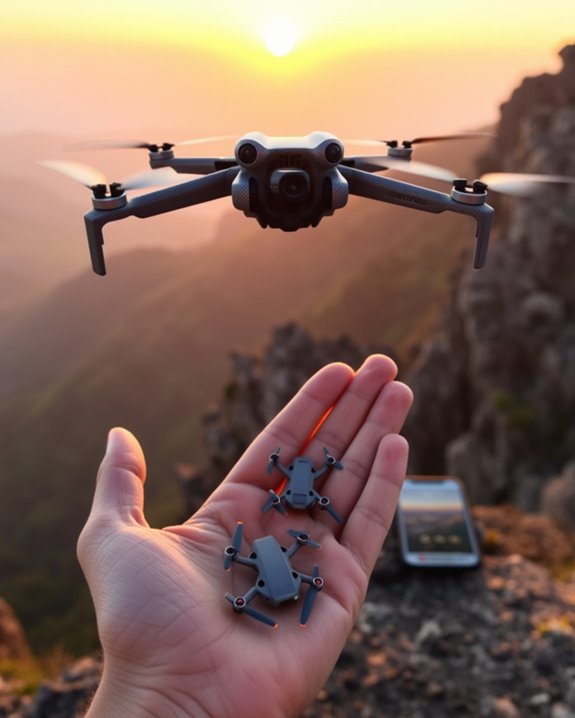
When you’re ready to buy your mini drone, you’ll need to weigh several important factors that can make or break your flying experience. Your perfect pocket aircraft depends on elements like camera quality, battery life, portability, stability in windy conditions, and how far you can fly it without losing connection! These considerations will help you navigate the sea of options and find a mini drone that matches your specific needs, whether you’re capturing aerial photos or just enjoying the thrill of flight.
Camera Quality and Resolution
Just how much detail do you want to capture on your aerial adventures? Today’s mini drones pack impressive camera technology that rivals much larger models! When selecting your perfect pocket flyer, pay attention to resolution—4K or 6K cameras deliver stunning clarity that’ll make your footage truly pop.
Look for drones with advanced CMOS sensors, which dramatically improve color vibrancy and perform admirably even as the sun sets. A 3-axis gimbal is non-negotiable if you’re serious about smooth footage, keeping your videos steady even when winds kick up to level 5.
Consider what frame rates matter to you—24fps creates that cinematic feel, while 60fps captures fast action without blur. Don’t forget about file formats, too! MP4 video and JPEG photos strike that perfect balance between quality and shareability on your social channels.
Flight Time and Battery
Moving from what your drone captures to how long it can stay airborne, flight time becomes your next big decision factor! Most mini drones offer between 12 and 96 minutes of flying time, which varies dramatically depending on the battery capacity you choose.
Look for models with higher mAh ratings—many quality minis feature 2230mAh or 3200mAh batteries that’ll keep you buzzing longer. Smart pilots always grab drones that include multiple batteries (two or three is ideal), allowing you to swap them mid-session for extended adventures up to 70 minutes!
Don’t forget to check if your prospective drone supports parallel charging. Those 60W hubs that recharge multiple batteries in just 1.3 hours? Absolute game-changers! Remember, windy conditions drain power faster, so those brushless motors aren’t just fancy features—they’re your ticket to maximizing every precious minute of flight time.
Portability and Weight
The magic of mini drones lies in their grab-and-go nature, with portability often becoming the deciding factor for adventure-seeking pilots! Those featherweight flyers under 250 grams aren’t just easier to toss in your backpack—they’ll also save you from registration headaches in many regions.
When evaluating your next pocket-sized aircraft, remember that weight impacts more than just carrying convenience. A lighter drone typically offers better maneuverability, while heavier models provide greater wind resistance during those breezy outdoor shoots. Look for foldable designs with collapsible arms and propellers that transform your tech from flying machine to packable wonder in seconds!
You’ll also want to evaluate the weight-to-battery ratio, as a drone that’s too light might sacrifice flight time—the ultimate balancing act for the on-the-go aerial photographer!
Stability and Wind Resistance
Wind-fighting capabilities make all the difference between capturing that perfect sunset shot and watching your mini drone tumble away like an expensive tumbleweed! When shopping for your pocket-sized flyer, look for models equipped with 3-axis gimbals, which compensate for vibrations and keep footage smooth even when breezes kick up.
Brushless motors aren’t just fancy tech jargon—they provide superior thrust and stability compared to their brushed counterparts, giving you confidence in gustier conditions. The best mini drones now come with optical flow sensors that enable precise hovering in winds up to level 5, while altitude hold technology automatically adjusts power to maintain consistent height. For extended adventures, seek out models with advanced flight modes that can battle the elements for up to 70 minutes! Your tiny aerial companion shouldn’t surrender to the first wisp of wind.
Control Range and Connectivity
Three key factors separate pocket-sized performers from frustrating flyaways: control range, signal stability, and connectivity options! You’ll want to evaluate how far you can safely pilot your mini drone before it drifts beyond your reach. Most quality minis offer ranges from 300 meters to 2+ kilometers, depending on their transmission technology.
Wi-Fi connected models are perfect for casual backyard flights, while digital transmission systems deliver that buttery-smooth FPV experience you’re craving. Remember, your actual range will likely shrink in windy conditions or urban environments with lots of interference.
Planning to fly between trees or buildings? Look for models with 5GHz capability for zippy data transfer, but don’t forget that higher frequencies sometimes struggle with obstacles. Your mini’s connectivity directly impacts your flying fun – choose wisely!
Beginner-Friendly Features
Launching your first mini drone shouldn’t require a pilot’s license! Today’s mini drones come packed with features that make your maiden flight less intimidating. One-key takeoff and landing functionality lets you start and stop flights with a single button press, eliminating those nerve-wracking manual takeoffs.
Headless mode is a game-changer for newbies, as it means you don’t need to track which way your drone is facing—just push forward and it moves away from you! Auto-return functions act like digital guardian angels, automatically bringing your drone home when battery runs low or signal weakens. Features like altitude hold and optical flow positioning keep your drone steady while you master basic controls. And don’t overlook gesture controls and user-friendly apps that let you snap perfect aerial selfies with a simple hand wave!
Frequently Asked Questions
How Long Does It Take to Become Proficient at Flying Mini Drones?
Ah, the delusion of instant drone mastery, where thumbs become wizards overnight! You’ll typically need 2-4 weeks of regular practice to become comfortable flying mini drones. Start with 15-minute daily sessions in open spaces, mastering hovering before attempting figure-eights and other maneuvers. Most beginners achieve decent control within 10 flight hours, but weather conditions and drone features affect your learning curve. Remember, crashes are inevitable learning experiences, not failures! Practice makes perfect, so keep flying!
Are Mini Drones Legal to Fly in National Parks?
No, you can’t fly mini drones in national parks. The National Park Service has banned all unmanned aircraft, including your cute little flyers, from these protected spaces! There are a few exceptions where special permits exist, but as a general rule, your drone must stay grounded. The restrictions protect wildlife, preserve natural quiet, and safeguard visitor safety. If you’re itching to fly, check out state parks instead—many allow drones with certain limitations.
Can Mini Drones Withstand Light Rain or Wind?
Most mini drones aren’t built to handle rain, so you’ll want to keep your tiny flyer grounded during wet weather! However, many can handle light winds up to 10-15 mph, though you’ll notice shakier footage and reduced flight stability. Higher-end models like the DJI Mini 4 Pro offer better wind resistance, while budget options might struggle in even gentle breezes. For the occasional drizzle, consider water-resistant models or aftermarket protective covers to give your drone some modest weather protection.
How Do Mini Drones Perform in Cold Weather Conditions?
Mini drones typically struggle in cold weather! You’ll notice reduced flight times as batteries drain faster, sometimes by 30-40% in temperatures below freezing. Most consumer models aren’t designed for winter conditions, and their small motors may become sluggish or lock up. For best performance, keep your drone above 32°F, let it warm up before flight, and store batteries at room temperature. Some higher-end mini drones feature thermal protection, but you’ll still want to limit exposure to extreme cold.
What Happens if My Mini Drone Flies Out of Signal Range?
When your mini drone flies out of range, most modern models will automatically initiate a “return-to-home” function, guiding your little flyer safely back to its takeoff point! If your drone lacks this feature, you’ll likely experience video signal loss first, followed by complete control loss. Your drone might hover briefly before landing wherever it is, or worse, continue flying until the battery dies. That’s why it’s smart to keep your drone within visible range, especially if you’re still mastering those controls!



